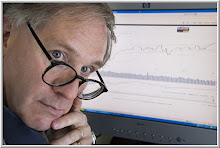 Here's a longer-term picture of 10-year interest rates. Note how the steep rise in 1999 choked off the stock market rally in 2000. It took a precipitous drop in rates to get the stock market going starting in 2003. Now we see rates once again rise over 5%, not far from multi-year highs.
Here's a longer-term picture of 10-year interest rates. Note how the steep rise in 1999 choked off the stock market rally in 2000. It took a precipitous drop in rates to get the stock market going starting in 2003. Now we see rates once again rise over 5%, not far from multi-year highs. What this tells us is that it takes some persistence of rising or falling rates to affect the valuation of equities. A single move higher in rates is not sufficient to induce a bear market. Still, the recent pattern of higher lows and higher highs is worth noting as a yellow flag for this market. Note that rises in rates early in 2004 and during mid-2006 were associated with stock market corrections.
Rates have risen from a low of approximately 4.6% to the current 5% over the past 20 trading sessions. I note that, as of Wednesday, only 434 stocks across the NYSE, NASDAQ, and ASE were making 20 day highs against 1001 new lows. My Demand indicator stands at 23 vs. 165 for Supply. That tells us that stocks with significant downside momentum (those closing below their short- and intermediate-term moving averages) outnumber those with significant upside momentum by about 7:1. It does appear that the rising rates are taking a toll on stocks.
In upcoming posts I'll look at which sectors are responding most notably to the rising rates, and I'll update my money flow indicators to see if the rising rates are leading institutions to withdraw money from the large-cap equities that have sustained this rally.
RELATED POST:
When Yields Are High, Should We Buy?




